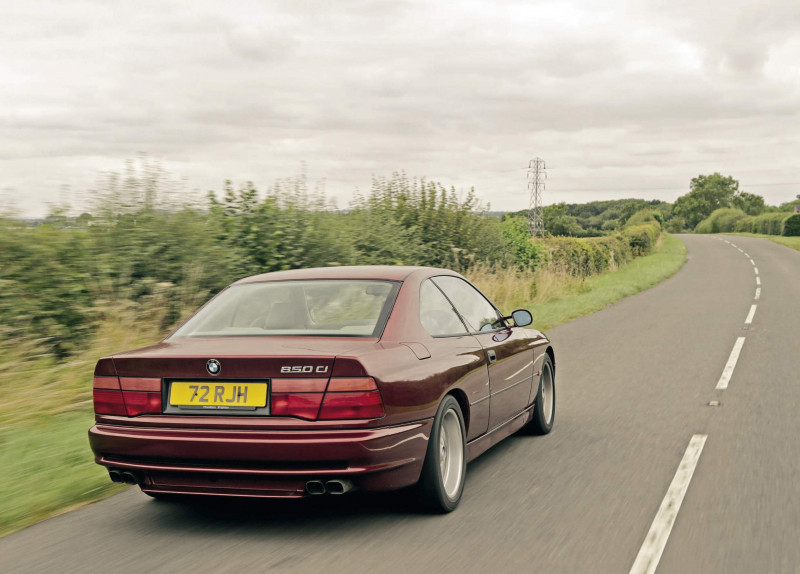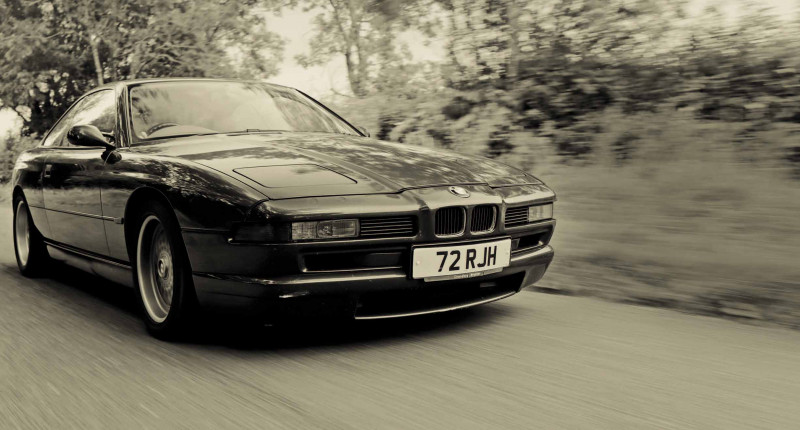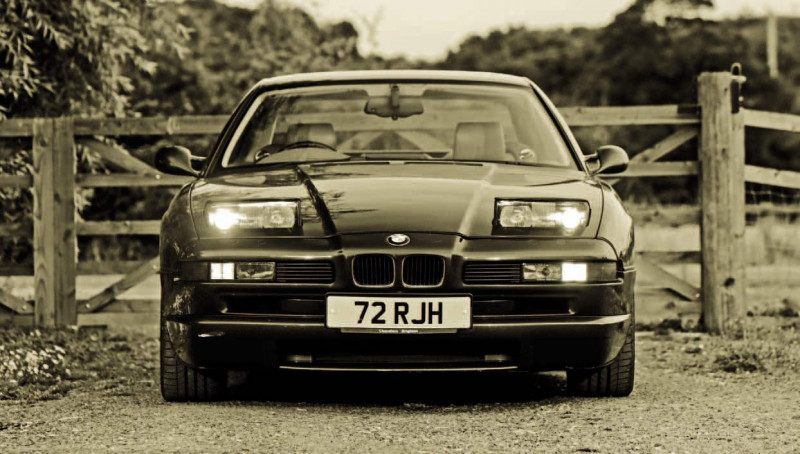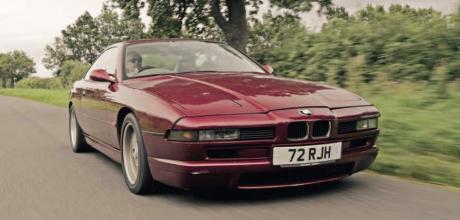1993 BMW 850Ci E31
BMW created the 8 Series to take on the GT elite. It was a technical tour de force that redefined the exotic mileeater as we know it, but does it still stack up? We try an 850Ci to find out. Words: Richard Dredge Pictures: Richard Dredge and Vicky Kitchen.
Driven: 1993 BMW 850Ci E31
Piece of 8 BMW 850CI: bavarian V12 GT put through its paces
Familiarity breeds contempt, apparently. So does unfamiliarity. Those in the know, and those who know people who are in the know, swear that the BMW 8 Series didn’t live up to the billing. It was a soulless technocrat that was good but not great. It was a ‘nearly’ car, an anomaly in an otherwise long and illustrious line of super-coupés from Bavaria. Clearly the knowledgeable have never driven one. Spend time with an 8 Series and you will discover a car that is misunderstood but not misguided, a mile-eater that coddles its pilot; where comfort trumps lateral g-force bragging rights.

Which was rather the point of the exercise way back when. It was – and remains – a wafter par excellence, a fact that is not lost on us as we guide this 850Ci along a long stretch of straight and typically pockmarked asphalt in the middle of somewhere. It’s just so… relaxing. Or at least it is until you clock the speedo and realise you’re doing the sort of speeds that will land you in court, if not the chokey. Whoa there, big fella. It is a GT car in the original sense of the term, one where the ability to cross continents in a single bound was paramount.
“It is a GT car in the original sense of the term, one where the ability to cross continents in a single bound was paramount.”
The 8 Series in any of its various guises is a grand tourer, but that perhaps isn’t what the marque faithful expected in period. BMW had form when it came to premium coupés, stretching all the way back to the Giorgetto Giugiaro-styled, Bertone-crafted 3200 CS in the early 1960s. The pointy-nosed 2000 CS and lithe CS/CSL coupés that followed in its wake were masterworks of form and proportion, the latter strain also being true driver’s cars. Then there was the 6 Series E24, production of the new and old worlds overlapping briefly in 1977.

It’s worth recalling that while the 8 Series E31 has yet to undergo a reputational reappraisal, the same is not true of the 6 Series coupé in all its many flavours. BMW’s ambition to chase American dollars ensured the E24-series GTs were more luxurious but also accommodated stringent safety requirements. As such, there were impact bumpers, larger overhangs to facilitate the need for crumple zones, and so on. With added structural bolstering came extra weight, the upshot being that brickbats were inevitably levelled at the newcomer from some quarters.
But it sold. And how. While pitchfork-wielding types frothed at the mouth for what they weren’t, others raved about the 630CS and its 633CSi stablemate for what they were: refined and practical grand tourers. A facelift in 1982 aided the 6 Series’ cause further, as did the release of other variants such as the magnificentM635CSi E24 to the point that around 86,000 of all kinds were sold to 1989. That was almost twice as many as the preceding E3-generation coupés. As such, the doubters had been silenced and E24s remain classics of their kind. The followup would abide by the same basic template – pace plus luxury plus safety – but throw a lot more in besides.

In terms of architecture and appointment, the 8 Series (E31 in BMW speak) was in a different league. It was light years more advanced than its predecessor; than most cars. Aesthetically, it couldn’t have been further removed from previous models although, intriguingly, the outline for this brave new world bore a striking resemblance to Paul Bracq’s preliminary renderings for the 6 Series coupé bar the pop-up headlights. Nevertheless, despite its pointy nose and bulging flanks, some stylistic DNA was carried over if you looked closely enough, not least the obligatory ‘Hoffmeister Kink’ return curvature of the rearmost size glazing. Unveiled in 850i form at the 1989 Frankfurt motor show, powering this super-GT was a 296bhp V12. This was followed two years later by the mighty 850CSi, a 5.6-litre, 381bhp behemoth with the bearing to match. In early 1993, BMW added the 840Ci to the line-up, the entry-level model sporting a 4.0-litre, 286bhp V8. A mooted cabriolet edition, one which dealers were clamouring for, did not make the leap to production status, though. Nor, sadly, did the 550bhp M8 E31 variant (although the850CSi E31 really was an M-series car in all but name). Intriguingly, BMW also considered offering a three-litre V8 version, and 18 prototypes were built, but the scheme was abandoned. In any of its various guises, there was no doubting the intent to create a class-leading machine; the sort of car that would crush the opposition. Impressively, the E31 had a drag coefficient of just 0.29. That figure is remarkable still, and represented a massive improvement over its predecessor. It was also the first V12 production car to feature a six-speed manual ’box (a four-speed auto was also available). It also employed such cutting-edge technologies as ASC+T traction/stability control, a fly-by-wire throttle and a hydraulic Servotronic steering and ARAK (Active Rear Axle Kinematics) rear axle arrangement. It enabled the rear wheels to respond to the car’s speed and steering angle and turn in the same direction by up to two degrees. Along with the fun-but flawed Z1 roadster, it also boasted an integrated multi-link set-up.
Then there was the cabin. Unlike some other BMWs of the period, where everything was an optional extra, here the driver wanted for nothing. It was wall-to-wall leather and electric doodads. All of this techno-wondrousness and wanton luxury came at a price, mind. BMW deliberately pitched the 8 Series at several market segments north relative to that of the 6 Series and, as such, even the ‘base’ model was eye-wateringly expensive. Scroll back to 1994 and the 840Ci cost £52,950 (roughly £102,000 adjusted for inflation). The 850CSi, by contrast, would have set you back a whopping £77,500 (around £161,000 in new money).
As such, it was in rarefied company at a time when the exotica establishment wasn’t quite ready to cede territory. And it isn’t as though the 8 Series was universally feted. It was likened to the Vauxhall Calibra by one media outlet by way of a derisory comment. Given that the GM fastback was widely lauded for its styling at the time meant it was a bit of a cackhanded insult. Russell Bulgin, meanwhile, also made tart comments about the looks. He opined in CAR: ‘[It’s] a great shape – sinewy, taut – let down by a lack of confidence at the front end. Perhaps the design team’s pencil was worn down; more likely, we’ve all seen a Toyota Supra in the rear-view mirror once too often.’
There were also one or two criticisms levelled at the sheer amount of technological wizardry here; that perhaps it was a bit too starry-eyed for its own good. But the 8 Series did sell – initially. There was even a three-year waiting list. Unfortunately, the small matter of a global financial meltdown shortly thereafter dampened demand for profligate gasguzzlers.
Sales of the 850i and subsequent variations on the theme never lived up to expectations. The 850i/Ci received a displacement hike to 5.4 litres in 1995, a five-speed automatic transmission with Steptronic being added along the way. The CSi, by contrast, was dropped for good a year later. 1996 saw just 1465 cars leave the assembly line in Dingolfing. In 1998, it was a mere 663.
In May 1999, production ended after ten years, the final car made – an 840Ci – being destined for the factory museum. All told, 30,609 were sold, with the USA accounting for 6920 of those (to 1997 when the model was withdrawn). Rarest strain of all were the 24 cars made in South Africa from SKD (Semi Knocked-Down) kits. Somehow, you doubt BMW ever came close to recouping its DM 1.5bn investment, although it did attempt to put on a brave face by stating repeatedly that it had been the most successful V12-engined car ever made in terms of sales, around 22,000 8 Series coupés having been thus equipped.
But that was then. In the meantime, the 8 Series was suspended between used exotica and classicdom status. Prices were adjusted accordingly, and some cars fell down the food chain. Maintaining a car with this level of complexity isn’t for the faint of heart and inevitably some examples were used, abused and not looked after as well as they might have been. The same can be said of most cars of this ilk, though.
Inevitably, there is a bottoming out period and then suddenly everyone wants one. Whether that has happened here is debatable, but spend time with any iteration of 8 Series, regardless of engine, and you will discover a toweringly capable car. One that is hard not to admire.
In the mind’s eye, the 8 Series is a big car. Photos suggest as much but, in reality, it isn’t, at least not by today’s standards. That said, it isn’t what you might call dainty. Resplendent in a lustrous shade of Calypso Red, ‘our’ 1993 850Ci appears dart-like in profile and brawny with it, the bulging flanks in particular suggesting muscularity. It’s a distinctive outline; striking even, and one retrospectively attributed to Klaus Kapitza (who co-authored the third-gen Ford Escort). It still polarises opinion among arbiters of beauty, though, but there’s nothing wrong with that. To perpetuate a greatly overused journalistic cliché, it has presence.
It also has heft. According to period stats, the 850Ci tipped the scales at 1790kg. As such, it was heavier than any comparable SL-series Mercedes-Benz, and only fractionally lighter than the Aston Martin Virage. A short-wheelbase 750i saloon weighed only 10kg more. Nevertheless, you don’t approach a V12-engined super-coupé expecting it to be sylph-like, or a masterwork of packaging for that matter. The thing is, step – stoop – aboard and the cabin is well thought out, with oodles of space for the driver and passenger. Admittedly, it’s just the one passenger because the rear seats could only accommodate small children over a small distance – at a push.
“It still polarises opinion among arbiters of beauty… but there’s nothing wrong with that. To perpetuate a greatly overused journalistic cliché, it has presence.”
The front seats are sculptured nicely and can be electrically adjusted in all directions, the steering wheel being similarly adjustable for reach and height. Unusually for the period, the safety belts are integrated into the front seats. Ahead, the instruments are traditional BMW fare and elegantly functional with it, but supplementary information and other functions are displayed on a strip in the centre console, switchable by a touch of the left-hand stalk, or by pressing individual buttons – of which there are many. It would take days – weeks – to discern what functions they all serve.
Your first aural clue that this isn’t going to be a choral V12 in the chain-driven, multi-cam Italian tradition occurs on turning the ignition key. There’s a minor tremble at tickover, but that’s about it. No bursting into life; no drama. The four-speed auto transmission trumps the cumbersome six-speed Getrag manual for ease of use. You have two main choices for normal driving, Economy and Sport, plus a manual shift set-up.
Easing off the line with only the lightest caress of the throttle and, again, it picks up cleanly without the expected lurch. In town, the 850Ci is effortless and eerily devoid of engine noise; much of anything. Once out into the sticks, the car’s true character emerges: it remains the strong, silent type. Even with your foot planted and the throttle wide open, it doesn’t get particularly vocal. It’s almost eery. It is quick for its vintage, though. If period stats are to be believed, full-throttle upward shifts in Sport occur at 5800rpm. That equates to 54, 91 and 131mph. It doesn’t hang about, but this patently isn’t a car for hooligans and should not be approached as such.
Driven with decorum, it goes about its business discreetly, with only a little tyre roar intruding. There are no bypass valves and pop-pop-pop exhaust theatrics. It’s just so… tranquil. 8 Series BMWs were sold with a variety of suspension set-ups, all of which accordingly have an effect on handling behaviour. With Sport suspension, which is predictably a bit tauter than the standard set-up, the ride is comfortable around town, and surprisingly good at speed over ridges and depressions. There’s none of the nose-dipping behaviour you get in many other big-engined GTs of the period.
Unless you like living on the edge, it’s hard to imagine reaching – or breaching – the BMW’s limits in the real world; certainly not on public roads. It’s all rather undramatic: the mildest of mild understeer under power and a tightening of line when the throttle is closed. Lurid tail out action would require provocation. Should you wish to indulge in such behaviour, it would be prudent to attempt it where there is plenty of run-off area (and perhaps in close proximity to a hospital). Make no mistake, this isn’t the sort of car you want to get out of shape. Somehow, you imagine you will need lightning quick reflexes to gather it all up again. The basic laws of physics still apply for all the driver aids. Fortunately, the brakes scrub off speed rapidly and there’s plenty of pedal feel.
There are some who claim that 8 Series BMWs are overly anodyne, and it’s fair to say that driving one isn’t an immersive, interactive experience. There is an element of truth to that argument, but only in terms of refinement trumping sensation. That was the point of the exercise. This was a car for butting against the 155mph limiter along the autobahn, only without the white-knuckle terror bit. BMW set out to build the ultimate GT car rather than the Ultimate Driving Machine. Whether it succeeded is a moot point, but it was certainly a candidate for the most advanced of the period.
Russell Bulgin summed it up best in CAR after pitching a Jaguar XJR-S and a Porsche 928 S4 against an 8 Series E31. He wrote: ‘In the present company, the 850i is the slowest, the least engaging in recreational driving and, of course, the most civilised, the easiest to live with, the most elegant, the best built and the car you would pick to drive to Geneva, whatever the weather, whatever the reason.’ That, in a nutshell, is what GT cars were once all about but are not any more.
Thanks to: Jane Weitzmann at jhwclassics.com


